Australia So Much to See


The East MacDonnell Ranges 2008. We explore further east, visiting Arltunga, the site of a gold rush which commenced in 1887 and the first significant settlement in Central Australia.
Leaving the caravan and following a scenic drive through the ranges and cattle stations from Trephina Gorge, we spent a full day at
Arltunga Historical Reserve. This reserve features well set out displays depicting the history of

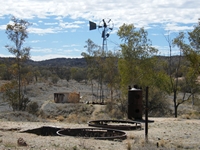
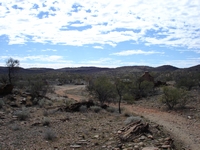
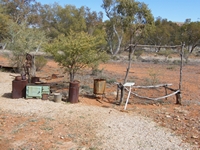
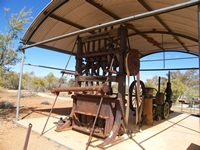
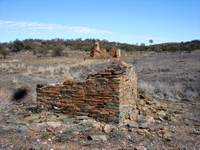
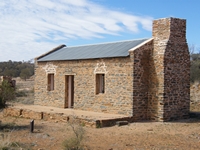
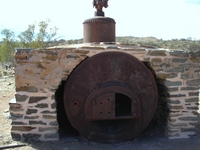
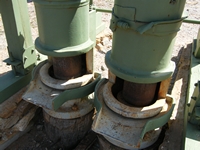
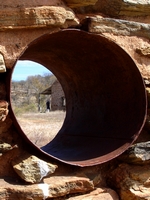
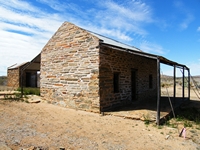
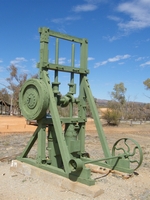
On entry to the park, a visitor centre has information boards, and a video giving an insight into the history of the gold mining days
can be viewed. Outside there is a collection of items from the gold rush days and a display for hands on experience on how to
pan for gold.
In 1887 there were over 200 people in the area prospecting for rubies. At the beginning of the 'ruby' rush European buyers were
keen but by mid 1888 it was found that the stones were merely high grade garnets. The ruby boom quickly collapsed.
The gold rush was short lived, with the Government Battery finally being closed in 1913. There have been sporadic attempts at
further mining in the area, and currently (2008) there is mining is taking place in the
Steam produced by this furnace powered a ten stamp battery for crushing the ore.
Higher up the hill at the range, this shaft has been tunnelled horizontally into the hill, with a slight downward slope. A primitive
wooden support can be seen to the left of the continuing tunnel. Take a torch to enter this tunnel.
The old Police Station and adjacent goal cell were originally built in 1912, and have been restored. The Police Station can
be glimpsed through a window of time – an old primitive window made from a kerosene tin in a cottage wall.
old Police station.
There are several walk trails amongst old diggings, ruins and broken dreams. We took walk trails at Golden Chance, Christmas
Creek,
Quartz seams can be seen running along the hillsides, but many of the mines did not provide high yields.
There is some evidence of copper in the quartz.
The walk trail to the
At Christmas Creek,
the open cut mining along the creek line was short lived, and the
A MacDonnell Range Reef mine has been set out well for visitors. A mine has been covered with a grid for safety, and a ladder
provided for visitors to climb down into it. If you hunch right down, you can crawl though one of the tunnels and up the ladder
at another exit.
We did not visit Ruby Gap, which is a further 45 kilometres east of Arltunga. Ruby Gap is the site of the first mining rush
in
By 1887 alluvial gold had been discovered in a creek near Paddy's Rockhole, which lead to the establishment of the Arltunga Goldfield. Arltunga was the first town in central
The restored Manager’s Residence, which had two rooms and verandahs and as such was the most impressive residence in Arltunga.
At Golden Chance one of the small diggings shows the quartz vein. Outside each of these tiny mines is a pile of broken up quartz;
a sign of a mine which did not live up to the hopes of the miners.
The main mine at Golden Chance was worked between 1998 and 1904, and only yielded approximately 58 ounces (1.8 kilograms) of gold
in total.
Ruins of stones cottages show no mortar was used in this harsh and dry land.
Passing the Crossroads and the Crossroads Cemetery, we headed further east to the lower diggings at Joker Gorge, but we did not
climb the range to the Joker Mine. From there a further walk goes to the Gorge. From 1899 to 1908, 27 ounces (800 grams)
of gold were produced from the Joker Mine.
It must have been so hard picking the rocks to make a tunnel while in a semi crouching position.
Again, small wooden supports
have been used.
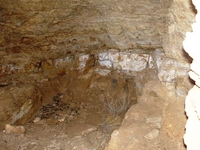
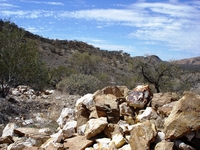
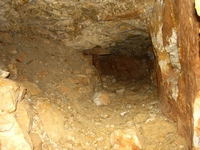
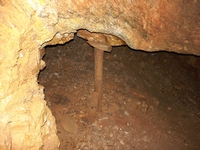
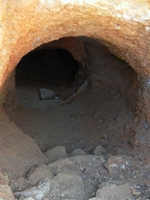
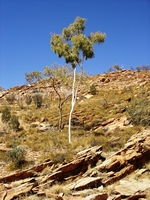
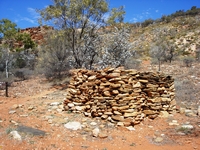
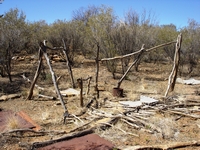
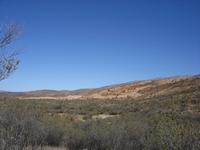
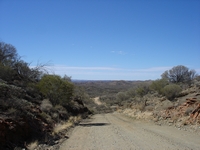
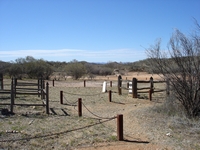
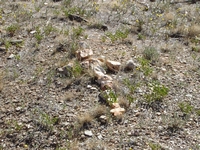
The Great Western Mine is one of the mines in the
Production figures for the Arltunga
mines have been taken from on site fact sheets.
Although most remnant buildings were made of stone, there was evidence of a few timber and iron dwellings. This dwelling
probably had brush walls. It was probably used during the second phase of mining in the 1930s at the Great Western site when
around 200 people were living on the goldfields.
Driving further east we headed to the
The ranges to the east are considerably
lower as we look into the distance.
The White range cemetery is one of two in the Arltunga reserve and is the larger of the two. This cemetery has eight marked
graves and a number of unmarked graves; one having a basic cross of stones.
A short walk up the hill from the cemetery gives views to the
The activity seen
at the foot of the range in the distance may have been part of the clean up and rehabilitation of the site.
We returned to the Crossroads, which was chosen in 1900 as the site for a town. It never eventuated as mining waned. There
was once a hotel at this site and remains of a bake house can still be seen. From the Crossroads, the track north heads to the